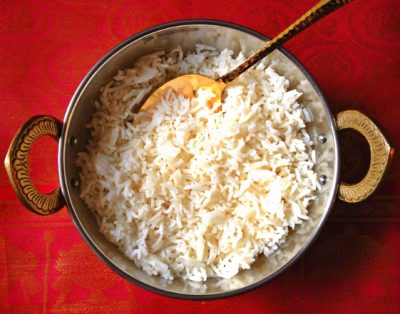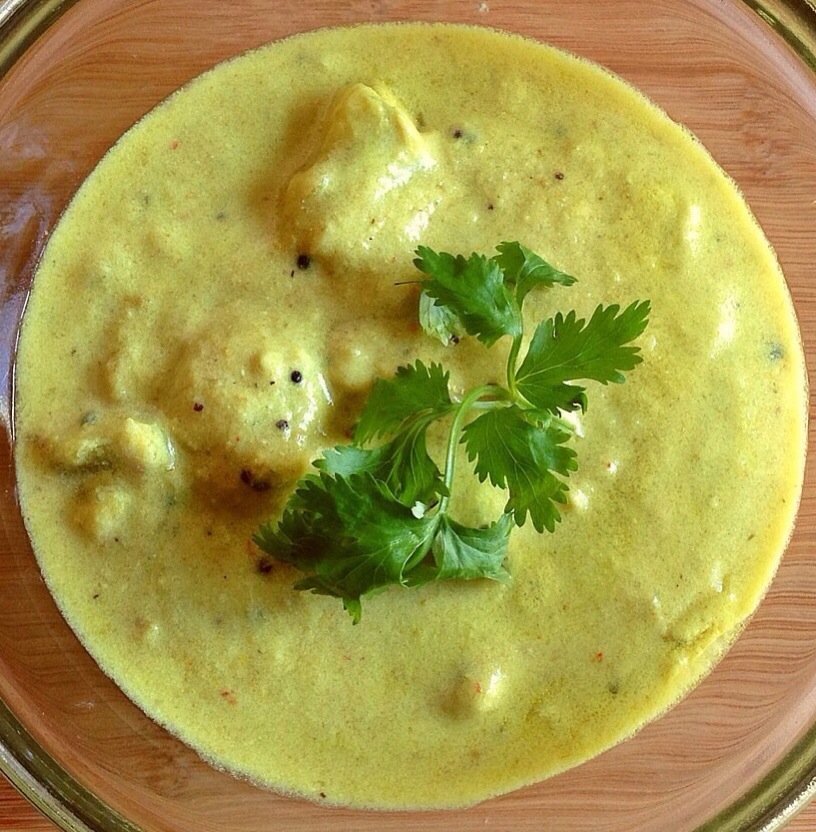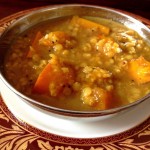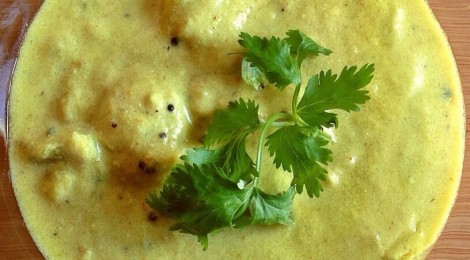
South Indian Green Yogurt Curry (Majjige Huli)
With spring around the corner here in New York City (well, it’s still 38F/3C and officially April, but I’m hopeful!), I’ve been craving vegetables and greens, especially lighter Indian dishes that are lovely in warmer weather. This ‘South Indian Green Yogurt Curry’ also known as ‘Majjige Huli’ is one of those dishes, and says Springtime to me — it’s light, lemony, and green. Translated, ‘Majjige’ means ‘buttermilk’ and ‘Huli’ is a lentil-based dish, also called ‘rasam’ or ‘sambar’ that is common in South India and Sri Lanka. I typically ask my mom to make it because, well, she makes it so well. And, because she usually makes it during Hindu festivals and celebrations, when her house is filled with fresh flowers, sandalwood incense, family and friends, reminding me of my childhood in Canada.
When my mom grew up in the South Indian town of Pavagada, near the border of Karnataka and Andhra Pradesh, the local farmers market took place every Monday, offering villagers the freshest vegetables from nearby farms. She and my grandmother would pick the best looking ‘chayote squash’ for this curry. Chayote squash is a small, hard squash from the gourd family, which is light green on the outside and inside. It’s quite hard when you peel and cut it, but once it’s cooked down, quickly becomes soft and translucent, offering the perfect tender bite in this preparation. Chayote squash is used in many cuisines and goes by many names, including “merleton” (Creole/Cajun), “chuchu” (Brazil), and Labu Siam (Indonesia), to name just a few.
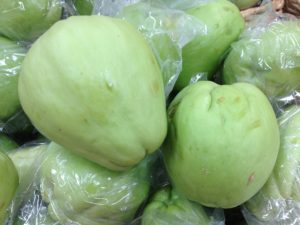
Chayote squash in my local Harlem grocer is usually from Costa Rica, which I use to make this South Indian green yogurt curry
So what does a “green yogurt curry” taste like exactly? It’s not at all like a Thai green curry, if that’s the first thing that pops into mind. I made this for my friend Alda, who is very familiar with Indian cuisine — she said it’s unlike anything she’s ever tasted before (it’s not a dish you will typically find on an Indian restaurant menu, but rather, is made at home). It has a fresh citrus taste that is rich and creamy because of the yogurt and sour cream, with smoky undertones thanks to classic South Indian flavors from tempered whole spices like mustard seeds and kari patha (curry leaves). Majjige huli is deceptively simple looking, yet is complex, bold and light all at the same time. It’s perfect over plain basmati rice.
South Indian Green Yogurt Curry (Majjige Huli)
Serves 4
Ingredients
- 2-3 tablespoons canola oil
- 1 teaspoon black mustard seeds
- 5-6 kari patha (curry leaves)
- 1/8 teaspoon asafetida (hing)
- 2 cups chayote squash, peeled, pitted & diced (you can substitute with zucchini, white pumpkin or any type of summer squash)
- 1-1/2 cups plain, non-fat yogurt
- 1/2 cup sour cream
- 1 teaspoon salt
- 1/2 teaspoon turmeric
Masala
Ingredients for Masala
- 2 tablespoons channa dal, soaked in water for an hour
- 1/2 cup fresh or frozen coconut
- 2 green chillies
- 1/2 cup fresh cilantro, chopped
- 1 teaspoon coriander seeds
- 1 teaspoon cumin seeds
- 1-inch piece fresh ginger, chopped
- 3/4 cup water
Preparation for Masala
- Grind the above ingredients for masala, including soaked channa dal, with 3/4 cup water. Set aside.
- In a small bowl, whisk together yogurt and sour cream. Set aside.
Preparation for curry
- Heat canola oil and mustard seeds on medium heat in a medium saucepan, with a tightly fitted lid. The mustard seeds will start to pop lightly, listen carefully, and as soon as the popping stops, remove the saucepan from the heat and add and the kari patha (curry leaves) and asafetida (hing). Return to burner, lower the flame, and watch it carefully so it doesn’t burn.
- Add the chopped vegetables and sauté for couple of minutes. Add turmeric, salt and 1/2 cup of water. Cook on low heat for about 10 minutes until the vegetables are just soft (a little softer than al dente). Be sure not to overcook, otherwise it will become mushy quickly.
- Add the ground masala, mix well and sauté for 2-3 minutes on low heat. Keep stirring to prevent it from sticking to the bottom of the saucepan. Add yogurt mixture, and bring it gently to a boil. As soon as it boils lightly, remove it from flame. Taste and adjust the seasonings for salt and pepper.
- When heating leftovers, do not boil, just heat gently.
